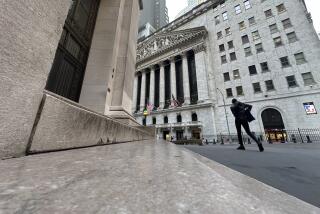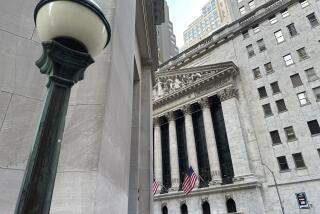Bond Prices Advance Again as Dollar Gains
NEW YORK — Bond prices pushed higher in light trading Tuesday, posting their third consecutive advance.
The Treasury’s benchmark 30-year bond rose 9/16 point, or $5.60 for every $1,000 in face amount. Its yield, which rises when prices fall, fell to 8.16% from 8.21% late Monday.
Elliott Platt, fixed-income research director for Donaldson Lufkin & Jenrette Securities, said the market appeared to be “retracing some ground lost last week when the dollar fell.”
He said bond traders have seen the dollar stage a comeback over the past few days despite earlier central bank efforts to drive it lower. A rising dollar makes dollar-denominated notes and bonds more attractive for foreign investors.
In the secondary market for Treasury bonds, prices of short-term governments rose 3/16 point to 9/32 point, intermediate maturities rose about 3/8 point and long-term issues rose as much as 19/32 point, the Telerate Inc. financial information service reported.
Yields on three-month Treasury bills auctioned Monday fell to 8.00% as the discount fell 11 basis points from the level at auction to 7.75%. Yields on six-month bills sold Monday fell to 8.26% as the discount fell 6 basis points from the level at auction to 7.83%. Yields on one-year bills fell to 8.36% as the discount fell 10 basis points to 7.77%.
The rates on three- and six-month bills quoted late Monday were for bills issued before the auction.
The federal funds rate, the interest on overnight loans between banks, was quoted at 9%, down from 9.063% late Monday.
Currency
The dollar rose against most major currencies despite continued central bank intervention as the crisis in Panama boosted the U.S. currency. Gold prices declined.
Foreign exchange analysts said intervention by the Federal Reserve and other central banks continued but at a less aggressive pace than last week.
The Group of Seven industrialized nations agreed more than a week ago to sell dollars and buy other currencies in a concerted effort to drive the dollar lower.
“The dollar was well bid throughout the entire day today,” said Jeff Montschein, managing director of foreign exchange at Continental Bank in Chicago. “The intervention was across the board but it wasn’t massive.”
Currency analysts said the dollar’s rise was led by a failure to push up the struggling yen.
In Tokyo, the dollar rose 1.35 yen to a closing 140.65 yen.
Later, in London, it was quoted at 141.10 yen, up from 139.25 late Monday. In New York, the dollar traded at 141.20 yen, up from 139.70.
News that the Panamanian government might have been overthrown in a coup also gave the dollar a slight kick, currency traders said. U.S. government officials later reported that the coup had failed.
In London, the dollar gained against the British pound. It cost $1.6055 to buy one pound, cheaper than $1.6175 late Monday. The pound fell to $1.6045 compared to $1.6135 in New York trading.
Gold fell in London to a late bid price of $365.50 an ounce, compared to late Monday’s $366.50.
In Zurich, gold closed at a bid $365.25 compared to $366.40 late Monday. Gold in Hong Kong fell 75 cents to close at a bid $366.50.
On the Commodity Exchange in New York, gold bullion for current delivery closed at $366.30 an ounce, down from $367.60 on Monday. Later Republic National bank of New York said gold was bid at $365.50 an ounce, down from Monday’s $366.10.
Commodities
Coffee futures prices sank to new life-of-contract lows on New York’s Coffee, Sugar & Cocoa Exchange after Brazil’s chief coffee executive said he saw no chance for a return to international price supports until next year.
On other commodity markets, livestock futures advanced, precious metals declined, energy futures rose, and grains and soybeans were mixed.
Futures prices for green, unroasted coffee settled 3.51 cents to 4.03 cents lower, with the contract for delivery in December at 76.50 cents.
All contracts established new lifetime lows during the session but none fell below 74.80 cents, the 14-year low established Aug. 14 by the now-expired September contract.
The heaviest selling occurred early in the session after Jorio Dauster, president of the Brazilian Coffee Institute, said he saw no possibility of a new international coffee agreement before next March, when the new Brazilian president takes office.
Hog futures rose sharply on the Chicago Mercantile Exchange in response to higher-than-expected cash prices and strengthening chart signals. Cattle futures rebounded from Monday’s steep losses.
Live cattle settled 0.08 cent to 0.35 cent higher, with October at 71.35 cents a pound; feeder cattle were 0.05 cent lower to 0.35 cent higher, with October at 82.75 cents a pound; live hogs were 0.05 cent lower to 0.93 cent higher, with October at 45.10 cents a pound, and frozen pork bellies were 0.05 cent to 0.50 cent lower, with February at 48.50 cents a pound.
More to Read
Inside the business of entertainment
The Wide Shot brings you news, analysis and insights on everything from streaming wars to production — and what it all means for the future.
You may occasionally receive promotional content from the Los Angeles Times.










